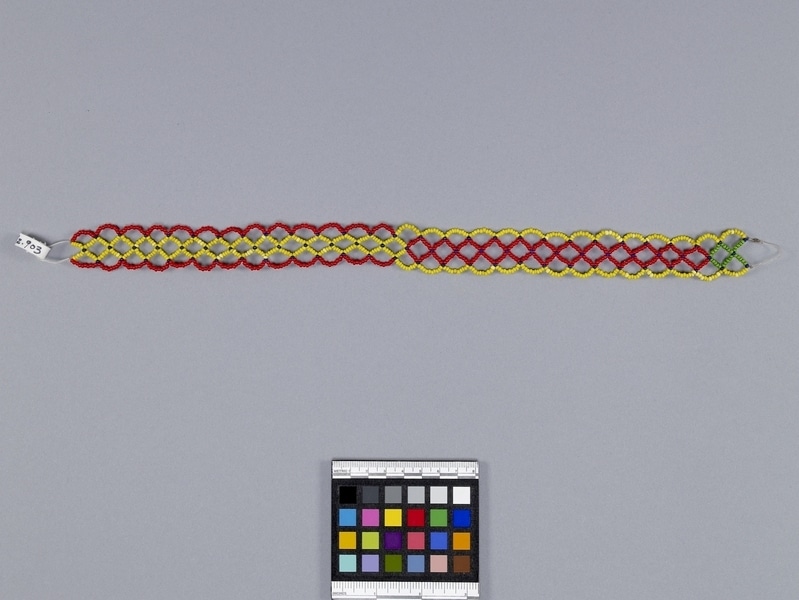Band Item Number: Edz903 from the MOA: University of British Columbia

Description
Band of glass beads woven on nylon line. The pattern is a row of lozenges along longitudinal axis of the band at centre. There are blue beads at each corner of lozenges with semicircles along edges attached to lateral points of lozenges. Half of the lozenges and semi-circles are red and half are yellow, except for one and one half green diamonds.
History Of Use
Ornamental chin fastening for hat worn as everyday wear. At the time this hat band was collected, there were many families who lived on boats in the waters around Hong Kong and Macao, and made their living by fishing. The boats varied in size from small sampans to large boats capable of deep-sea fishing. Their fishing methods varied according to the size and type of boat as well as the types of equipment used. They were generally forbidden to go on land except to sell their fish, to bream their boats, to get fresh water, and to bury their dead, and hence their children were deprived of the opportunity to go to school, giving them the added burden of illiteracy. In the 1970s, this situation began to change as the Hong Kong government created housing for them on land and places for the children in schools. Now (2013) there are almost certainly no families living on their fishing boats, and the significance of fishing as an occupation has greatly declined.
Narrative
Contrary to common belief at the time this hat band was collected, Cantonese boat-dwelling fishing people shared most cultural traits with other Cantonese people. Differences were determined primarily by their boat-dwelling lifestyle and the fact that they fished for a livelihood.
The term “Tanka” by which they were commonly known is derogatory. A more respectful term is “Seuih Seuhng Yahn”: people who live on the water.
Cultural Context
Used by Cantonese speaking boat-dwelling women and men for everyday wear.
Item History
- Made in Macau before 1976
- Collected during 1976
- Owned by Elizabeth L. Johnson before September 2, 1976
- Received from Elizabeth L. Johnson (Donor) on September 2, 1976
What
- Name
- Band
- Identification Number
- Edz903
- Type of Item
- band
- Material
- glass and nylon fibre
- Manufacturing Technique
- strung
- Overall
- height 41.5 cm, width 2.5 cm
Who
- Culture
- Chinese: Cantonese
- Previous Owner
- Elizabeth L. Johnson
- Received from
- Elizabeth L. Johnson (Donor)
Where
- Holding Institution
- MOA: University of British Columbia
- Made in
- Macau
When
- Creation Date
- before 1976
- Collection Date
- during 1976
- Ownership Date
- before September 2, 1976
- Acquisition Date
- on September 2, 1976
Other
- Item Classes
- textiles; beadwork
- Condition
- good
- Accession Number
- 0328/0003 b